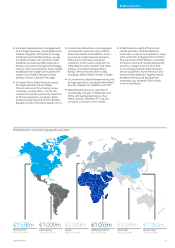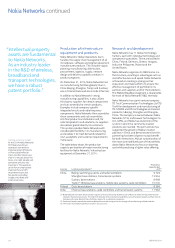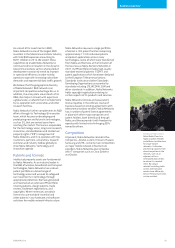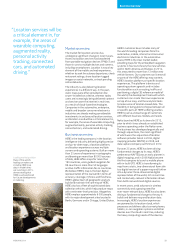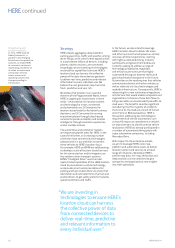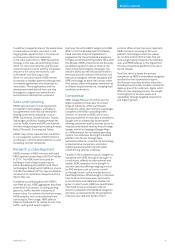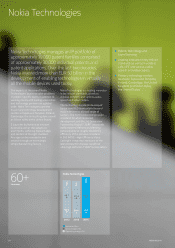Nokia 2014 Annual Report Download - page 26
Download and view the complete annual report
Please find page 26 of the 2014 Nokia annual report below. You can navigate through the pages in the report by either clicking on the pages listed below, or by using the keyword search tool below to find specific information within the annual report.
24 NOKIA IN 2014
Nokia Networks continued
Production of infrastructure
equipment andproducts
Nokia Networks’ Global Operations team
handles the supply chain management of all
its hardware, software and original equipment
manufacturer products. This includes supply
planning, manufacturing, distribution,
procurement, logistics, supply, network
design and delivery capability creation in
product programs.
On December 31, 2014, Nokia Networks had
six manufacturing facilities globally: four in
China (Beijing, Shanghai, Tianjin and Suzhou),
one in Finland (Oulu) and one in India (Chennai).
In addition to Nokia Networks’ strong
manufacturing capabilities, it also utilizes
third-party suppliers for certain components
and sub-assembly for certain products.
Examples include company-specic
integrated circuits and radio frequency
components. Nokia Networks then assembles
these components and sub-assemblies
intonal products and solutions and, for
selected products and solutions, its suppliers
also deliver goods directly to customers.
Thissystem provides Nokia Networks with
considerable exibility in its manufacturing
and enables it to meet demands related to
cost, availability and customer requirements
more easily.
The table below shows the productive
capacity per location of major manufacturing
facilities for Nokia Networks’ infrastructure
equipment at December 31, 2014.
Research and development
Nokia Networks has 11 Global Technology
Centers, each with individual technology and
competence specialties. These are located in
China, Finland, Germany, Greece, Hungary,
India, the Philippines, Poland and the
United States.
Nokia Networks organizes its R&D teams in a
at structure, resulting in advantages such as
cost eectiveness and speed. Nokia Networks
is focused on creating a strong partner
ecosystem and makes eorts to ensure the
eective management of portfolio for its
partners and suppliers and for their products.
The Mobile Broadband segment is responsible
for most of Nokia Networks’ R&D internally.
Nokia Networks has a joint venture company
TD Tech Communication Technologies Ltd (TD
Tech) for development and manufacturing of
TD-SCDMA and LTE technologies and related
products in Beijing, Shanghai and Chengdu,
China. The company is owned between Nokia
Networks (51%) and Huawei Technologies Co.
Ltd. (49%), and Nokia has ownership of the
system in which the commonly created
products are inserted. The joint venture has
supported the growth of Nokia’s market
position in China, and demonstrates that this
partnering has been of great mutual benet
for both enterprises. Mutual customization of
the most commoditized part of the portfolio
allows Nokia Networks to focus on lowering
cost while producing ahigher value oering.
“Intellectual property
assets are fundamental
toNokia Networks.
Asan industry leader
inthe R&D ofwireless,
broadband and
transport technologies,
we have a robust
patent portfolio.”
Gaining customer insight
At the 2014 Nokia Networks
CEM Executive Forum,
operators learned how
implementing CEM results
in nancial benets for
them. Another lesson was
that it is not just about the
tools—the right people and
processes are also very
important. The operators
atthe forum emphasized
that their future CEM
requirements are also
focused on providing
insights into xed and
internet services.
Country Location and products (1)
Productive
capacity, Net
(m2)(2)
China Beijing: switching systems and radio controllers 6 749
Shanghai: base stations, transmission systems 15 954
Suzhou: base stations 8 968
Tianjin(3): Wireless base stations, mobile core systems, radio controllers 10 000
Finland Oulu: base stations 8 364
India Chennai: base stations, radio controllers and transmission systems 11 962
(1) Nokia Networks considers the production capacity of its manufacturing facilities to be sucient to meet the requirements of its
network infrastructure business. The extent of utilization of its manufacturing facilities varies from plant to plant and from time to
time during the year. None of these facilities is subject to a material encumbrance.
(2) Productive capacity equals the total area allotted to manufacturing and to the storage of manufacturing-related materials.
(3) The Tianjin manufacturing facility was sold in January 2015.











